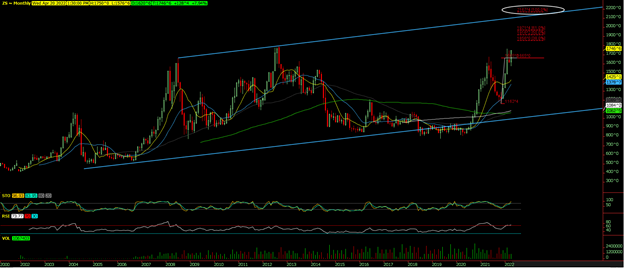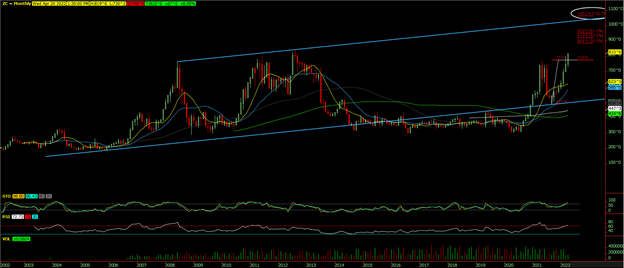
Last month’s blog highlighted technical circumstances to watch for that would indicate fund liquidation is underway. What a waste of time that was! Instead, both old and new crop corn contracts have rallied about $1.10, while old crop soybeans are roughly 90 cents higher and new crop soybeans are 65 cents higher.
Planting intention data at the end of March was a key driver for corn’s gains, but what has been even more impressive was the ability of soybeans to shake off bearish acreage data. Soybeans made a low on April 1, the day after the report, and have done nothing but rally since.
As of today’s session, both old and new crop soybeans have forged an outside month higher during the month of April. This means that soybeans were trading below the March low to start the month of April, and today we had both old and new crop soybeans trading above the March monthly high. This is generally a bullish indicator if it can maintain into the end of the month.
Strength in soybeans can at least partly be attributed to the ongoing export pace of old crop soybeans, and we will receive an update to this dataset tomorrow morning; as of last week’s sales data, only 1.7 million bushels of soybeans were needed per week to hit USDA’s export goal for the marketing year; 20.2mb were sold last week. On the shipment front, 22.8mb need to leave the country each week to hit USDA’s target; 29.6mb were shipped.
This would suggest that as we move ahead to the next WASDE report in May, USDA will likely have enough data to push soybean exports a touch higher, thereby further reducing old crop stocks on paper. The May WASDE will also be our first look at the new crop balance sheets. USDA will use the planting intentions from the report at the end of March, assume a trend-line yield on those acres, and then provide a demand assessment for new crop. Any reduction to old crop ending stocks moving forward will come right off the top of new crop assumptions.
With Brazil’s drought this winter reducing their crop by roughly 20 million metric tonnes from early estimates, old crop soybean demand should remain stout considering U.S. soybeans are competitive vs. South American beans through May, and the cheapest from June out. May soybeans trading 30 cents premium to July soybeans illustrates the appetite for soybeans right now. For comparison, May corn is trading about 6 cents higher than July corn.
While I’m not excited to say these prices out loud, I will let the chart do the talking and show you the long-term, big picture upside price objective for soybeans:

Corn has a similar story as soybeans for exports, and the case is building for even stronger sales soon if the Safrinha crop in Brazil goes backwards due to hot and dry conditions. Last week’s sales data showed 52.5mb of old crop sales with only 15.2mb required each week to hit USDA’s export target. Shipments are also on track with 61.4mb leaving the country versus a required pace of 55.4mb per week.
Even though corn spreads aren’t trading quite a bullish as soybean spreads, from a flat price perspective May corn settled today less than 30 cents from the record high in 2012 of 843’6. Although we could say we are now in a weather market due to delayed planting, I wouldn’t consider us in the “real” weather market quite yet when the trade attempts to determine how weather during pollination will affect yields. While the timing and conditions of planting can’t be ignored, temperatures and precipitation during pollination will have the largest impact on yield potential.
My point in saying this would be to illustrate that record prices for corn are within a day or two of solid gains away, and that’s without a legitimate weather issue that could come two months down the road.
Again, it’s hard to say the number out loud, so I’ll let the chart do the talking to show the long-term price objective for corn:

I continue to feel that the largest price risk for agricultural commodities is something in the macro environment. The fund length in nearly all commodity markets is aggressive to say the least. A policy change from the government or a macroeconomic black swan could turn things abruptly, but for now the trend is up and the trend is your friend. If you would any assistance in protecting the value of your crop, as always, feel free to contact me directly at 815-665-0463 or anyone on the AgMarket.Net team at 844-4AGMRKT. We are here to help.
The risk of loss in trading futures and/or options is substantial and each investor and/or trader must consider whether this is a suitable investment. AgMarket.Net is the Farm Division of John Stewart and Associates (JSA) based out of St Joe, MO and all futures and options trades are cleared through ADMIS in Chicago IL. This material has been prepared by an agent of JSA or a third party and is, or is in the nature of, a solicitation. By accepting this communication, you agree that you are an experienced user of the futures markets, capable of making independent trading decisions, and agree that you are not, and will not, rely solely on this communication in making trading decisions. Past performance, whether actual or indicated by simulated historical tests of strategies, is not indicative of future results. Trading information and advice is based on information taken from 3rd party sources that are believed to be reliable. We do not guarantee that such information is accurate or complete and it should not be relied upon as such. Trading advice reflects our good faith judgment at a specific time and is subject to change without notice. There is no guarantee that the advice we give will result in profitable trades. The services provided by JSA may not be available in all jurisdictions. It is possible that the country in which you are a resident prohibits us from opening and maintaining an account for you.
The opinions of the author are not necessarily those of Farm Futures or Farm Progress.
About the Author(s)
You May Also Like




